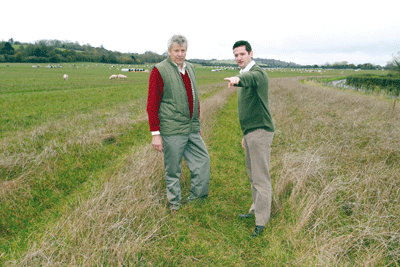Hampshire farm policy aims for better water protection

At first hearing, Catchment Sensitive Farming may seem just another well-meaning phrase dreamt up by politicians keen to put the brakes on productive agriculture.
But when your land lies beside a world famous chalk-stream fishery in Hampshire the nationally led CSF programme makes a lot of sense, according to Geoff Butler.
As managing director of Bossington Farms, Houghton, through which the River Test flows, he acknowledges his farming activities are bound to come under extra scrutiny if it is to remain in the pristine condition so eagerly sought by fly fishermen.
To that end CSF practices now protect the river from contamination by soil and nutrients coming from the land and the farm’s livestock.
And similar plans and actions can be valuably employed on many other farms to tackle diffuse water pollution, says Chris Giles, Natural England’s lead catchment sensitive farming officer for the south-east.
Mr Giles and local CSF officer Nigel Thomas-Childs of the Environment Agency have been helping pinpoint the farm’s river defence strategies and tactics.
“Soil and nutrient management plans don’t just help avoid problems, they can save money and help meet environmental requirements,” says Mr Giles.

Geoff Butler (left) and Nigel Thomas-Childs in the double buffer strip protecting the Wallop brook, just beyond the lane on the right, from contamination by the farm’s outdoor pigs.
“Catchment Sensitive Farming is all about resource protection and demonstrating due diligence,” adds Mr Thomas-Childs. “It can give you peace of mind when it comes to inspections.”
For Mr Butler the introduction of CSF and the government’s Higher Level Stewardship agri-environment scheme came just at the right time.“Ideally we wouldn’t be farming here,” says Mr Butler. “But we can’t move the estate.”
The farm, already in a Nitrate Vulnerable Zone, covers about 890ha. Just over half is arable, growing wheat, oilseed rape, spring barley and maize.
However, it was flooding in November 2000 that made Mr Butler examine his operations more closely.
“We had 2.5in of rain in 24 hours. Run-off from some fields with outdoor pigs and others with potatoes flooded houses and coloured the river. We had to do something.”
Since then measures combining CSF and HLS have been put in place to avoid the same thing happening again.
Many farmers practise them already, stresses Mr Giles. It is not only agriculture that is responsible for such incidents and for rising phosphate levels in rivers.
“I’m keen to promote what farming is doing right, and generally farmers manage their soils very well here in the south.”
CSF’s aims include encouraging best practice in using fertilisers, manures and pesticides, explains Mr Thomas-Childs.
“It promotes good soil structure to maximise rain infiltration, and reduces run-off and erosion.”
It also strives to avoid contaminating watercourses with livestock faeces, and sediments.
The hope is that CSF’s delivery initiative (see box) can ease some of the regulatory burden that the EU’s Water Framework Directive might impose on farmers, explains Mr Giles.
Mr Butler admits he was fortunate in qualifying for HLS which partly offset the costs.
Since the flood, buffer strips of low input grass have been sown in several places to catch soil before it washes from the fields. In one particularly sensitive field close to Wallop brook which runs into the Test there is now a double buffer along one edge, part HLS-funded.
Such guard areas are carefully managed, he says.
“It took our staff and keepers some time to come to terms with what we were doing. But now if I catch anyone driving down these strips they’ll get a severe reprimand.”
On the steeply sloping area which led to the flooding, about 3ha are now in HLS arable reversion with natural regeneration stablising the soil.
Fields destined for maize are left as over-winter stubbles, and the 600-sow outdoor pig herd is less intensively stocked to reduce poaching. “We used to run them over under 100 acres. Now they have 120.”
Dispersing the 220-cow dairy, mainly for sheer economic reasons, also clearly helped. “It was only 200 yards from the river,” he points out.
Soil, Nutrient and Manure Management Plans, all underpinning the new river defence strategy, have been drawn up.
The whole arable area has also been intensively mapped for nutrients by SOYL, and a GPS-driven application system is being employed to guard against over-dressing parts of fields with phosphate and potash.
“We haven’t seen any big savings yet, but at least we know we’re only applying fertiliser where it’s needed.
